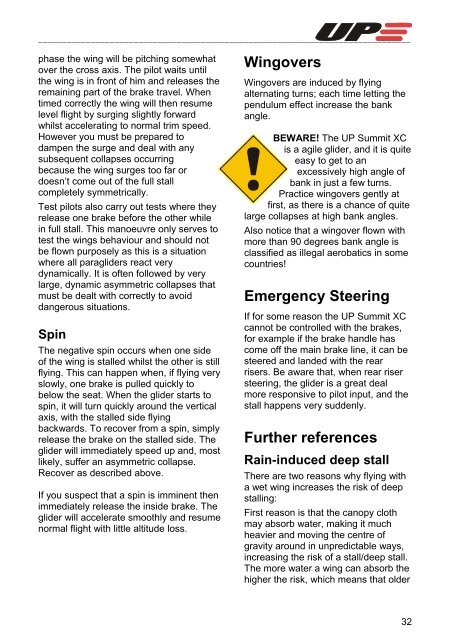Owners Manual and Service booklet
Owners Manual and Service booklet
Owners Manual and Service booklet
You also want an ePaper? Increase the reach of your titles
YUMPU automatically turns print PDFs into web optimized ePapers that Google loves.
______________________________________________________________________________<br />
phase the wing will be pitching somewhat<br />
over the cross axis. The pilot waits until<br />
the wing is in front of him <strong>and</strong> releases the<br />
remaining part of the brake travel. When<br />
timed correctly the wing will then resume<br />
level flight by surging slightly forward<br />
whilst accelerating to normal trim speed.<br />
However you must be prepared to<br />
dampen the surge <strong>and</strong> deal with any<br />
subsequent collapses occurring<br />
because the wing surges too far or<br />
doesn’t come out of the full stall<br />
completely symmetrically.<br />
Test pilots also carry out tests where they<br />
release one brake before the other while<br />
in full stall. This manoeuvre only serves to<br />
test the wings behaviour <strong>and</strong> should not<br />
be flown purposely as this is a situation<br />
where all paragliders react very<br />
dynamically. It is often followed by very<br />
large, dynamic asymmetric collapses that<br />
must be dealt with correctly to avoid<br />
dangerous situations.<br />
Spin<br />
The negative spin occurs when one side<br />
of the wing is stalled whilst the other is still<br />
flying. This can happen when, if flying very<br />
slowly, one brake is pulled quickly to<br />
below the seat. When the glider starts to<br />
spin, it will turn quickly around the vertical<br />
axis, with the stalled side flying<br />
backwards. To recover from a spin, simply<br />
release the brake on the stalled side. The<br />
glider will immediately speed up <strong>and</strong>, most<br />
likely, suffer an asymmetric collapse.<br />
Recover as described above.<br />
If you suspect that a spin is imminent then<br />
immediately release the inside brake. The<br />
glider will accelerate smoothly <strong>and</strong> resume<br />
normal flight with little altitude loss.<br />
Wingovers<br />
Wingovers are induced by flying<br />
alternating turns; each time letting the<br />
pendulum effect increase the bank<br />
angle.<br />
BEWARE! The UP Summit XC<br />
is a agile glider, <strong>and</strong> it is quite<br />
easy to get to an<br />
excessively high angle of<br />
bank in just a few turns.<br />
Practice wingovers gently at<br />
first, as there is a chance of quite<br />
large collapses at high bank angles.<br />
Also notice that a wingover flown with<br />
more than 90 degrees bank angle is<br />
classified as illegal aerobatics in some<br />
countries!<br />
Emergency Steering<br />
If for some reason the UP Summit XC<br />
cannot be controlled with the brakes,<br />
for example if the brake h<strong>and</strong>le has<br />
come off the main brake line, it can be<br />
steered <strong>and</strong> l<strong>and</strong>ed with the rear<br />
risers. Be aware that, when rear riser<br />
steering, the glider is a great deal<br />
more responsive to pilot input, <strong>and</strong> the<br />
stall happens very suddenly.<br />
Further references<br />
Rain-induced deep stall<br />
There are two reasons why flying with<br />
a wet wing increases the risk of deep<br />
stalling:<br />
First reason is that the canopy cloth<br />
may absorb water, making it much<br />
heavier <strong>and</strong> moving the centre of<br />
gravity around in unpredictable ways,<br />
increasing the risk of a stall/deep stall.<br />
The more water a wing can absorb the<br />
higher the risk, which means that older<br />
32


